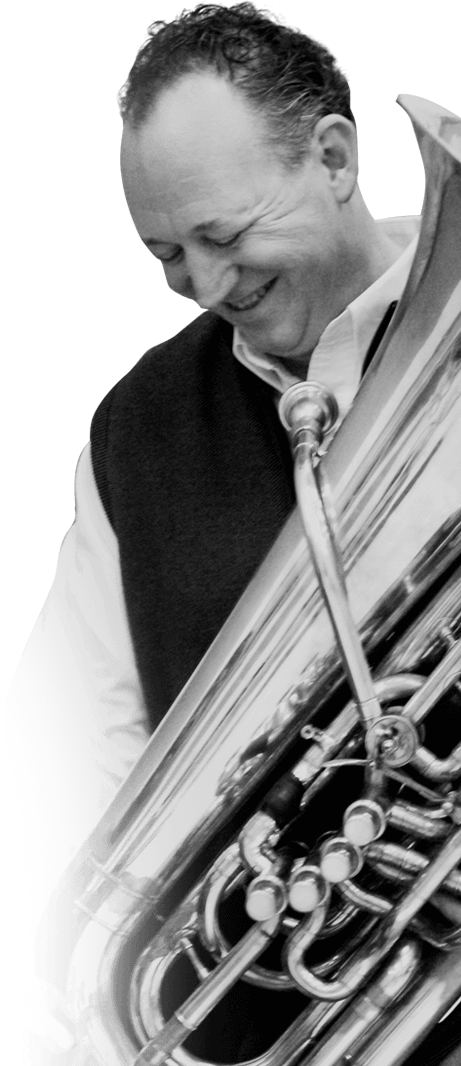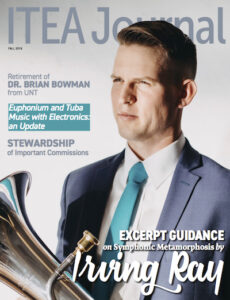Jim Shearer’s Music for Tuba and String Quartet highlights five pieces by living composers, and one that has been all but forgotten to the annals of time. Shearer opens his CD with Manny Albam’s Quintet for Tuba and Strings, a work originally written for Harvey Phillips but which still remains unpublished. Shearer has gone to extensive lengths to resurrect this piece, and his program notes on the background and context of the work are particularly informative and reveal a great deal of energy Shearer has put into its revival. An accomplished jazz arranger and saxophone player, Albam’s “classical” writing is full of unexpected harmonies and conversational exchanges between the tuba and members of the string quartet. Shearer’s performance of this work showcases precisely why this piece should become a staple of the tuba repertoire.
The fifth track of the recording – Cauterizing the Soul by Justin Raines – is a sorrowful tribute to the poetry of Dan Skeleton. Emotive and melancholy, the interplay between the tuba and the string quartet showcases Shearer and the La Catrina Quartet’s emotive abilities. Winner of the 2014 Harvey Phillips Award for Composition Excellence, this piece would be an excellent addition to any chamber recital.
Inspired by the photography of Jim Gale, tracks six through nine feature Lon W. Chaffin’s Doors. Throughout its four movements, this piece utilizes a variety of percussive elements to incorporate new timbres and to evoke the imagery of Gale’s photos better. The second movement, “Old Leaning Lumber,” is particularly evocative with its slides in the strings and lilting tuba part. The asymmetrical meter of the third movement, “Out About Town,” lends itself to a jovial and lighthearted mood, expertly executed by La Catrina Quartet’s seamless transitions between pizzicato and arco playing. The final movement, “Blue Door Blues,” features an actual blues tune briefly interrupted by an interlude of chant- and gospel-inspired interjections. Shearer’s jazz background lends an effortless coolness to the movement that simply put, just grooves.
Originally commissioned for the attendees of the 2014 International Tuba-Euphonium Conference in Bloomington, Indiana, this reviewer is sure that many of our readers already have James Grant’s Remember? in our collective libraries. Shearer’s recording with string quartet – and the tenth track of this CD – however, offers a new rendering of this piece. The sparse string accompaniment provides a ghostly and delicate compliment to Shearer’s emotional interpretation of Grant’s theme.
The eleventh track of this CD features Lester Pack’s Quintet No. 1 for Tuba and String Quartet, a tour-de-force lasting twelve minutes and thirty seconds. Written in four movements with no breaks between the respective sections, the piece opens with an energetic two-part tuba melody over dissonant polychords in the string accompaniment. The second movement of the piece is an adagio with a brief quote of “Nimrod” from Elgar’s Enigma Variations as a nod to Jim Shearer’s competitive barbeque nickname. The third movement of the piece utilizes an ostinato idea in the string parts with a jazz waltz-inspired theme in the tuba melody. A cadenza in the solo tuba part brings the third movement to a close and introduces the fourth and final movement of the piece. The ensemble then moves through a variety of thematic material in an ABCAB form, culminating in what Pack describes as a “bit of a dramatic final cliff-hanger ending.”
The final track of the CD features a lovely lyrical ballad in the style of “Satie by way of Mancini”, according to composer James Grant. Originally written for solo piano, Waltz for Betz exists in versions for each of the principal woodwind, brass, and string instruments playing the solo line, each of which is also available with four different accompaniments. Shearer’s playing floats over the La Cantina Quartet’s accompaniment with ease, showcasing his powerful music-making abilities and offering a lovely end to an even lovelier CD.
-Genevieve Clarkson, Oklahoma City University
Originally Published in the ITEA Journal Fall 2018 edition

